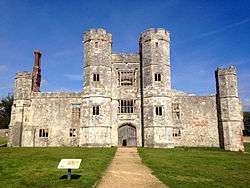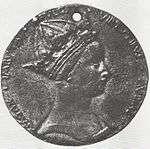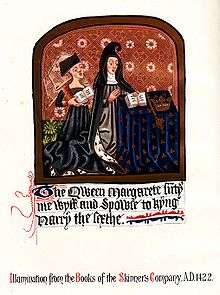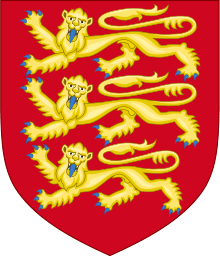Margaret of Anjou
| Margaret of Anjou | |
|---|---|
 Margaret of Anjou, detail from the Talbot Shrewsbury Book | |
| Queen consort of England | |
| 1st tenure | 23 April 1445 – 4 March 1461 |
| Coronation |
30 May 1445, Westminster Abbey |
| 2nd tenure | 3 October 1470 – 11 April 1471 |
| Born |
23 March 1430 Pont-à-Mousson, Lorraine |
| Died |
25 August 1482 (aged 52) Anjou |
| Burial | Angers Cathedral, Anjou |
| Spouse | Henry VI, King of England |
| Issue | Edward of Westminster, Prince of Wales |
| House | Valois-Anjou |
| Father | René, King of Naples |
| Mother | Isabella, Duchess of Lorraine |
| Religion | Catholicism |
Margaret of Anjou (French: Marguerite; 23 March 1430 – 25 August 1482) was the Queen of England by marriage to King Henry VI from 1445 to 1461 and again from 1470 to 1471. Born in the Duchy of Lorraine into the House of Valois-Anjou, Margaret was the second eldest daughter of René, King of Naples, and Isabella, Duchess of Lorraine.
She was one of the principal figures in the series of dynastic civil wars known as the Wars of the Roses and at times personally led the Lancastrian faction. Owing to her husband's frequent bouts of insanity, Margaret ruled the kingdom in his place. It was she who called for a Great Council in May 1455 that excluded the Yorkist faction headed by Richard of York, 3rd Duke of York, and this provided the spark that ignited a civil conflict that lasted for more than 30 years, decimated the old nobility of England, and caused the deaths of thousands of men, including her only son Edward of Westminster, Prince of Wales, at the Battle of Tewkesbury in 1471.
Margaret was taken prisoner by the victorious Yorkists after the Lancastrian defeat at Tewkesbury. In 1475, she was ransomed by her cousin, King Louis XI of France. She went to live in France as a poor relation of the French king, and she died there at the age of 52.
Early life and marriage
Margaret was born on 23 March 1430[1] at Pont-à-Mousson in Lorraine, a fief of the Holy Roman Empire east of France ruled by a cadet branch of the French kings, the House of Valois-Anjou. Margaret was the second daughter of René, King of Naples and of Isabella, Duchess of Lorraine. She had five brothers and four sisters, as well as three half-siblings from her father's relationships with mistresses. Her father, popularly known as "Good King René", was duke of Anjou and titular king of Naples, Sicily and Jerusalem; he has been described as "a man of many crowns but no kingdoms". Margaret was baptised at Toul in Lorraine and, in the care of her father's old nurse Theophanie la Magine, she spent her early years at the castle at Tarascon on the River Rhône in Provence and in the old royal palace at Capua, near Naples in the Kingdom of Sicily. Her mother took care of her education and may have arranged for her to have lessons with the scholar Antoine de la Sale, who taught her brothers. In childhood Margaret was known as la petite créature.


On 23 April 1445, Margaret married King Henry VI of England, who was eight years her senior, at Titchfield Abbey in Hampshire. The king and queen of France were the uncle and aunt of the groom and the bride respectively: Henry's late mother, Catherine, had been the sister of King Charles VII, whose wife Marie of Anjou was a sister of Margaret's father René. Further, Henry claimed for himself the Kingdom of France, and controlled various parts of northern France. Due to all this, the French king agreed to the marriage of Margaret to his rival on the condition that he would not have to provide the customary dowry and instead would receive the lands of Maine and Anjou from the English. The English government, fearing a highly negative reaction, kept this provision secret from the English public.
Margaret was crowned Queen Consort of England on 30 May 1445 at Westminster Abbey by John Stafford, Archbishop of Canterbury at the age of fifteen.[2] She was described as beautiful, and furthermore "already a woman: passionate and proud and strong-willed".[3] Those that anticipated the future return of English claims to French territory believed that she already understood her duty to protect the interests of the Crown fervently.[4] She seems to have inherited this indomitability from her mother, who fought to establish her husband's claim to the Kingdom of Naples, and from her paternal grandmother Yolande of Aragon, who actually governed Anjou "with a man's hand", putting the province in order and keeping out the English.[3] Thus by family example and her own forceful personality, she was fully capable of becoming the "champion of the Crown".[3]
Birth of a son
Henry, who was more interested in religion and learning than in military matters, was not a successful king.[5] He had reigned since he was only a few months old and his actions had been controlled by protectors, magnates who were effectively regents. When he married Margaret, his mental condition was already unstable and by the birth of their only son, Edward of Westminster, Prince of Wales (born 13 October 1453), he had suffered a complete breakdown. Rumours were rife that he was incapable of begetting a child and that the new Prince of Wales was the result of an adulterous liaison. Many have speculated that either Edmund Beaufort, 2nd Duke of Somerset, or James Butler, 5th Earl of Ormond, both staunch allies of Margaret, was the young prince's actual father.
Although Margaret was aggressively partisan and had a volatile temperament,[3] she shared her husband's love of learning by dint of her cultured upbringing and gave her patronage to the founding of Queens' College, Cambridge.
Elizabeth Woodville (born ca 1437), later Queen of England as future wife of her husband's rival, King Edward IV, purportedly served Margaret of Anjou as a maid of honour. However, the evidence is too scanty to permit historians to establish this with absolute certainty: several women at Margaret's court bore the name Elizabeth or Isabella Grey.[6]
Beginnings of the dynastic civil wars
Enmity between Margaret and the Duke of York

After retiring from London to live in lavish state at Greenwich, Margaret was occupied with the care of her young son and did not display any signs of political will until she believed her husband was threatened with deposition by the ambitious Richard of York, 3rd Duke of York,[8] who, to her consternation, had been appointed Lord Protector while Henry was mentally incapacitated from 1453 to 1454. The duke was a credible claimant to the English throne and by the end of his protectorship there were many powerful nobles and relatives prepared to back his claim. The Duke of York was powerful; Henry's advisers corrupt; Henry himself trusting, pliable, and increasingly unstable; Margaret defiantly unpopular, grimly and gallantly determined to maintain the English crown for her progeny. Yet at least one scholar identifies the source of the eventual Lancastrian downfall not as York's ambitions nearly so much as Margaret's ill-judged enmity toward York and her over-indulgence in unpopular allies.[9] Nevertheless, Queen Margaret was a powerful force in the world of politics. King Henry was putty in her hands when she wanted something done.[10]
Margaret's biographer Helen Maurer, however, disagrees with earlier historians having dated the much-vaunted enmity between the Queen and York to the time he obtained the office of the protectorship. She suggests the mutual antagonism came about two years later in 1455 in the wake of the First Battle of St Albans, when Margaret perceived him as a challenge to the king's authority. Maurer bases this conclusion on a judicious study of Margaret's pattern of presenting gifts; this revealed that Margaret took a great deal of care to demonstrate that she favoured both York and Edmund Beaufort (Somerset) equally in the early 1450s. Maurer also claims that Margaret appeared to accept York's protectorship and asserts there is no substantial evidence to back up the long-standing belief that she was responsible for the Yorkists' exclusion from the Great Council following Henry's recovery (see below).[11]
The late historian Paul Murray Kendall, on the other hand, maintained that Margaret's allies Edmund Beaufort (Somerset) and William de la Pole, then Earl of Suffolk, had no difficulty in persuading her that York, until then one of Henry VI's most trusted advisers, was responsible for her unpopularity and already too powerful to be trusted. Margaret not only convinced Henry to recall York from his post as governor in France and banish him instead to Ireland, she repeatedly attempted to have him assassinated during his travels to and from Ireland, once in 1449 and again in 1450.[12] Edmund Beaufort (Somerset) and Suffolk's joint responsibility for the secret surrender of Maine in 1448, and then the subsequent disastrous loss of the rest of Normandy in 1449 embroiled Margaret and Henry's court in riots, uprisings by the magnates, and calls for the impeachment and execution of Margaret's two strongest allies. It also might have made an ultimate battle to the death between Margaret and the House of York inevitable by making manifest Richard's dangerous popularity with the Commons. Richard of York, safely returned from Ireland in 1450, confronted Henry and was readmitted as a trusted advisor. Soon thereafter, Henry agreed to convene Parliament to address the calls for reform. When Parliament met, the demands could not have been less acceptable to Margaret: not only were both Edmund Beaufort (Somerset) and Suffolk impeached for criminal mismanagement of French affairs and subverting justice, but it was charged as a crime against Suffolk (now a duke) that he had antagonised the king against the Duke of York. Further, the demands for reform put forward included that the Duke of York be acknowledged as the first councillor to the king, and the Speaker of Commons, perhaps with more fervour than wisdom, even proposed Richard, Duke of York, be recognised as heir to the throne.[13] Within a few months, however, Margaret had regained control of Henry, Parliament was dissolved, the incautious Speaker thrown in prison, and Richard of York retired to Wales for the time being.[14]
In 1457, the kingdom was again outraged when it was discovered that Pierre de Brézé, a powerful French general and an adherent of Margaret, had landed on the English coast and burnt the town of Sandwich. As leader of a French force of 4,000 men from Honfleur, he aimed at taking advantage of the chaos in England. The mayor, John Drury, was killed in this raid. It thereafter became an established tradition, which survives to this day, that the Mayor of Sandwich wears a black robe mourning this ignoble deed. Margaret, in association with de Brézé, became the object of scurrilous rumours and vulgar ballads. Public indignation was so high that Margaret, with great reluctance, was forced to give the Duke of York's kinsman Richard Neville, 16th Earl of Warwick, a commission to keep the sea for three years. He already held the post of Captain of Calais.[15]
Leader of Lancastrian faction
Hostilities between the rival Yorkist and Lancastrian factions soon flared into armed conflict. In May 1455, just over five months after Henry VI recovered from a bout of mental illness and Richard of York's protectorship had ended, Margaret called for a Great Council from which the Yorkists were excluded. The Council called for an assemblage of the peers at Leicester to protect the king "against his enemies". York apparently was prepared for conflict and soon was marching south to meet the Lancastrian army marching north. The Lancastrians suffered a crushing defeat at the First Battle of St Albans on 22 May 1455. Edmund Beaufort (Somerset), the Earl of Northumberland and Lord Clifford were killed, Wiltshire fled the battlefield and King Henry was taken prisoner by the victorious Duke of York. In March 1458 along with her husband and leading nobles of the warring factions, she took part in The Love Day procession in London.
In 1459, hostilities resumed at the Battle of Blore Heath, where James Tuchet, 5th Baron Audley, was defeated by a Yorkist army under Richard Neville, 5th Earl of Salisbury.
The Wars of the Roses
Early campaigns

While Margaret was attempting to raise further support for the Lancastrian cause in Scotland,[16] her principal commander, Henry Beaufort, 3rd Duke of Somerset,[17] gained a major victory for her at the Battle of Wakefield on 30 December 1460 by defeating the combined armies of the Duke of York and the Earl of Salisbury. Both men were beheaded and their heads displayed on the gates of the city of York. As Margaret was in Scotland at the time the battle had taken place, it was impossible that she issued the orders for their executions despite popular belief to the contrary.[18] She followed up with a victory at the Second Battle of St Albans (at which she was present) on 17 February 1461.[19] In this battle, she defeated the Yorkist forces of Richard Neville, 16th Earl of Warwick, and recaptured her husband. It was after this battle that she, in a blatant act of vengeance, ordered the execution of two Yorkist prisoners of war, William Bonville, 1st Baron Bonville, and Sir Thomas Kyriell, who had kept watch over King Henry to keep him out of harm's way during the battle. The king had promised the two knights immunity, but Margaret gainsaid him and ordered their executions by decapitation. It is alleged that she put the men on trial at which her son presided. "Fair son", she allegedly asked, "what death shall these knights die?" Prince Edward replied that their heads should be cut off, despite the king's pleas for mercy.[19]
Sojourn in France
The Lancastrian army was beaten at the Battle of Towton on 29 March 1461 by the son of the late Duke of York, the future Edward IV of England, who deposed King Henry and proclaimed himself king. Margaret was determined to win back her son's inheritance and fled with him into Wales and later Scotland. Finding her way to France, she made an ally of her cousin, King Louis XI of France, and at his instigation she allowed an approach from Edward's former supporter, Richard Neville, Earl of Warwick, who had fallen out with his former friend as a result of Edward's marriage to Elizabeth Woodville, and was now seeking revenge for the loss of his political influence. Warwick's daughter, Anne Neville, was married to Margaret's son Edward, Prince of Wales, in order to cement the alliance, and Margaret insisted that Warwick return to England to prove himself before she followed. He did so, restoring Henry VI briefly to the throne on 3 October 1470.
Final defeat at Tewkesbury
By the time Margaret, her son and daughter-in-law (Anne) were ready to follow Warwick back to England, the tables had again turned in favour of the Yorkists, and the Earl was defeated and killed by the returning King Edward IV in the Battle of Barnet on 14 April 1471. Margaret was forced to lead her own army at the Battle of Tewkesbury on 4 May 1471, at which the Lancastrian forces were defeated and her seventeen-year-old son Edward of Westminster was killed. The circumstances of Edward's death have never been made clear; it is not known whether he was killed in the actual fighting or executed after the battle by the Duke of Clarence. If he died in battle, he would have been the only Prince of Wales ever to do so. Over the previous ten years, Margaret had gained a reputation for aggression and ruthlessness, but following her defeat at Tewkesbury and the death of her only son, she was completely broken in spirit. After she was taken captive by William Stanley at the end of the battle, Margaret was imprisoned by the order of King Edward. She was sent first to Wallingford Castle and then was transferred to the more secure Tower of London. Henry VI was also imprisoned in the Tower in the wake of Tewkesbury and he died there on the night of 21 May; the cause of his death is unknown, though regicide was suspected. In 1472 she was placed in the custody of her former lady-in-waiting Alice Chaucer, Duchess of Suffolk, where she remained until ransomed by Louis XI in 1475.[20]
Death
Margaret lived in France for the next seven years as a poor relation of the king. She was hosted by Francis de Vignolles and died in his castle of Dampierre-sur-Loire, near Saumur (Anjou) on 25 August 1482 at the age of 52.[21] She was entombed next to her parents in Angers Cathedral, but her remains were removed and scattered by revolutionaries who ransacked the cathedral during the French Revolution.
Margaret's letters
Many letters, written by Margaret during her tenure as queen consort, still exist. One was written to the Corporation of London regarding injuries inflicted on her tenants at the manor of Enfield, which comprised part of her dower lands.[22] Another letter was written to the Archbishop of Canterbury.[23][24] Margaret's letters, which were typically headed with the words "By the Quene,"[25] are compiled in a book edited by Cecil Monro, which was published for the Camden Society in 1863.[26]
Ancestors
| Ancestors of Margaret of Anjou | ||||||||||||||||||||||||||||||||||||||||||||||||||||||||||||||||||||||||||||||||||||||||||||||||||||||||||||||||||||||||||||||||||||||||||||||||||||||||||||||||||||||||||||||||||||||||||||||||||||||||||||||||||||||||||||||||||||||||||||||||||||||||||||||||||||||||||||||||||||||||||||||||||||||||||||||||||||||||||||||||||||||||||||||||||||||||||||||||||||||||||||||||||||||||||||||||||||||||||||||||||||||||||||||||||||||||||||||||||||||||||||||||||||||||||||||||||||||||||||||||||||||||||||||||||||||||||||||||||||||||||||||||||||||||||||||||||||||||||||||||||||||||||||||||||||||||||||||||
|---|---|---|---|---|---|---|---|---|---|---|---|---|---|---|---|---|---|---|---|---|---|---|---|---|---|---|---|---|---|---|---|---|---|---|---|---|---|---|---|---|---|---|---|---|---|---|---|---|---|---|---|---|---|---|---|---|---|---|---|---|---|---|---|---|---|---|---|---|---|---|---|---|---|---|---|---|---|---|---|---|---|---|---|---|---|---|---|---|---|---|---|---|---|---|---|---|---|---|---|---|---|---|---|---|---|---|---|---|---|---|---|---|---|---|---|---|---|---|---|---|---|---|---|---|---|---|---|---|---|---|---|---|---|---|---|---|---|---|---|---|---|---|---|---|---|---|---|---|---|---|---|---|---|---|---|---|---|---|---|---|---|---|---|---|---|---|---|---|---|---|---|---|---|---|---|---|---|---|---|---|---|---|---|---|---|---|---|---|---|---|---|---|---|---|---|---|---|---|---|---|---|---|---|---|---|---|---|---|---|---|---|---|---|---|---|---|---|---|---|---|---|---|---|---|---|---|---|---|---|---|---|---|---|---|---|---|---|---|---|---|---|---|---|---|---|---|---|---|---|---|---|---|---|---|---|---|---|---|---|---|---|---|---|---|---|---|---|---|---|---|---|---|---|---|---|---|---|---|---|---|---|---|---|---|---|---|---|---|---|---|---|---|---|---|---|---|---|---|---|---|---|---|---|---|---|---|---|---|---|---|---|---|---|---|---|---|---|---|---|---|---|---|---|---|---|---|---|---|---|---|---|---|---|---|---|---|---|---|---|---|---|---|---|---|---|---|---|---|---|---|---|---|---|---|---|---|---|---|---|---|---|---|---|---|---|---|---|---|---|---|---|---|---|---|---|---|---|---|---|---|---|---|---|---|---|---|---|---|---|---|---|---|---|---|---|---|---|---|---|---|---|---|---|---|---|---|---|---|---|---|---|---|---|---|---|---|---|---|---|---|---|---|---|---|---|---|---|---|---|---|---|---|---|---|---|---|---|---|---|---|---|---|---|---|---|---|---|---|---|---|---|---|---|---|---|---|---|---|---|---|---|---|---|---|---|---|---|---|---|---|---|---|---|---|---|---|---|---|---|---|---|---|---|---|---|---|---|---|---|---|---|---|---|---|---|---|---|---|---|---|---|---|---|---|---|---|---|---|---|---|---|---|---|---|---|---|---|---|---|---|---|---|---|---|---|---|---|---|---|---|---|---|---|---|---|---|---|---|---|---|---|---|---|---|---|---|---|---|---|---|---|---|---|---|---|---|---|---|---|---|---|---|---|---|---|---|---|---|---|---|---|---|---|---|---|---|---|---|---|---|---|---|---|---|---|---|---|---|---|---|---|---|
| ||||||||||||||||||||||||||||||||||||||||||||||||||||||||||||||||||||||||||||||||||||||||||||||||||||||||||||||||||||||||||||||||||||||||||||||||||||||||||||||||||||||||||||||||||||||||||||||||||||||||||||||||||||||||||||||||||||||||||||||||||||||||||||||||||||||||||||||||||||||||||||||||||||||||||||||||||||||||||||||||||||||||||||||||||||||||||||||||||||||||||||||||||||||||||||||||||||||||||||||||||||||||||||||||||||||||||||||||||||||||||||||||||||||||||||||||||||||||||||||||||||||||||||||||||||||||||||||||||||||||||||||||||||||||||||||||||||||||||||||||||||||||||||||||||||||||||||||||

Depictions in fiction
Margaret is a major character in William Shakespeare's first tetralogy of History plays. Henry VI, Part 1, Part 2, Part 3 and Richard III. She is the only character to appear alive in all four plays, but due to the length of the plays for the taste of modern audiences, many of her lines are usually cut.[27] Shakespeare portrays Margaret as an intelligent, ruthless woman who easily dominates her husband and fiercely vies for power with her enemies. In Henry VI, Part 2 Margaret has an affair with the Duke of Suffolk and mourns his death by carrying around his severed head. In Henry VI, Part 3 she personally stabs the Duke of York on the battlefield after humiliatingly taunting him, and becomes suicidal when her son Edward is killed in front of her. Although in reality Margaret spent the rest of her life outside England after the death of her husband and son, Shakespeare has her return to the court in Richard III. Margaret serves as a Cassandra-like prophetess; in her first appearance she dramatically curses the majority of the nobles for their roles in the downfall of the House of Lancaster. All of her curses come to pass as the noblemen are betrayed and executed by Richard of Gloucester, and each character reflects on her curse before his execution. Shakespeare had famously described Margaret : "How ill-beseeming is it in thy sex/ To triumph like an Amazonian trull/ Upon their woes whom Fortune captivates."[28]
Margaret's prominence in Shakespeare has led many theatre-makers to interpret the story with her at the center, drawing from the plays she is featured in. An adaptation called Margaret of Anjou by Elizabeth Schafer and Philippa Kelly was performed in 2016 in London by By Jove Theatre Company[29] and at California Shakespeare Theater in 2018.[30] In 2018 the Royal Exchange theatre in Manchester premiered Queen Margaret, using all the lines spoken by Margaret over the four plays with additional material by playwright Jeanie O'Hare.[27]
Margaret is the title character of Giacomo Meyerbeer's 1820 opera Margherita d'Anjou.
In the 1963 production by the Royal Shakespeare Company of The Wars of the Roses, broadcast by the BBC in 1965 and 1966, Margaret was played by Peggy Ashcroft. In the second series of The Hollow Crown: The Wars of the Roses, a three-part television adaptation of the Tetralogy first broadcast in 2016, Margaret was portrayed by Sophie Okonedo.
- Margaret of Anjou has an important role in Bulwer-Lytton's The Last of the Barons (1843).
- Margaret of Anjou is the main character in Barnaby Ross's 1966 novel, The Passionate Queen - Barnaby Ross was a publisher's house name for historical novels written by various authors, among them Don Tracy, who wrote The Passionate Queen.
- Margaret of Anjou is the subject of Betty King's 1974 biographical novel Margaret of Anjou - a sympathetic portrayal.
- Margaret of Anjou is an important character in Sir Walter Scott's 1829 novel Anne of Geierstein, where she appears disguised as a beggar following her exile.
- Margaret of Anjou is the main character in Jean Plaidy's 1982 novel The Red Rose of Anjou.
- Margaret of Anjou is the important character in the early parts of Sharon Kay Penman's 1982 novel The Sunne in Splendour, up until the Battle of Tewkesbury.
- Margaret of Anjou is the subject of Alan Savage's 1994 novel Queen of Lions, a portrayal which imagines she had an exceptionally active sex life.
- Margaret of Anjou is one of the major characters in The Lady of the Rivers by Philippa Gregory (2011), narrated by Jacquetta of Luxembourg.
- She also appears in The White Queen by Philippa Gregory (2009), narrated by Elizabeth Woodville.
- She is mentioned in The Red Queen by Philippa Gregory (2010), narrated by Margaret Beaufort, Countess of Richmond and Derby.
- She also appears in The Kingmaker's Daughter by Philippa Gregory (2012), narrated by Anne Neville.
- Margaret of Anjou is the main character in Susan Higginbotham's 2011 novel The Queen of Last Hopes - a sympathetic portrayal.
- Margaret of Anjou is a major subject in Stormbird, the first book of Conn Iggulden's trilogy about The Wars of the Roses.
She also is the subject of a fictional biography, The Royal Tigress by a fictional character, David Powlett-Jones who is the main subject of To Serve Them All My Days, R.F. Delderfield's novel of a Welsh schoolmaster at a Devon public school from World War I to the Battle of Britain in the 1940s. Delderfield, in the person of Powlett-Jones, appears to have a very good grasp of Margaret's life and the Wars of the Roses, and the content and development of the book give us an entertaining sub-plot to the book's main narrative.
In the television series The White Queen (2013), based on Gregory's The Cousins' War novels, Margaret of Anjou is portrayed by Veerle Baetens.
She is also depicted in the German historical novel Das Spiel der Könige (the game of kings; covering the period 1455–1485, from 1st St Albans to Bosworth Field) by Rebecca Gablé.
Citations
- ↑ Brooke, C.N.L.; Ortenberg, V. (June 1988). "The Birth of Margaret of Anjou". Historical Research. 61 (146): 357–58. doi:10.1111/j.1468-2281.1988.tb01072.x.
- ↑ Margaret Lucille Kekewich, The Good King: René of Anjou and Fifteenth Century Europe, (Palgrave Macmillan, 2008), 101.
- 1 2 3 4 Kendall, p.19.
- ↑ Maurer, Helen E. (2004). Margaret of Anjou : Queenship and Power in Late Medieval England. Woodbridge: Boydell. p. 21. ISBN 978-1-84383-104-4.
- ↑ Sellar, W.C.; Yeatman, R.J. (1930). 1066 And All That. Methuen. p. 46.
- ↑ Smith, George (1975). The Coronation of Elizabeth Wydeville. Gloucester: Gloucester Reprints. p.28
- ↑ Boutell, p.276.
- ↑ Kendall, pp.30–31.
- ↑ Kendall, pp. 18, 19 & 24: "Excessive greed and ambition—the besetting sins of his contemporary peers—seem to have been largely absent from his character. It would require the unrelenting enmity of a queen to remind him that he owned a better title to the throne than Henry the Sixth," id. at 18." It appears that Richard, Duke of York, was neither aiming at the crown nor seeking more of a voice in the government than he was entitled to. He represented, to many Englishmen of the day, the only hope of rescue from the swamp of disorder and evil rule in which the realm was floundering." Id. at p.517, n8.
- ↑ Fraser, p.139.
- ↑ Review of Maurer, Helen (2003). Margaret of Anjou: Queenship and Power in Late Medieval England. Retrieved 1 March 2011
- ↑ Kendall, pp. 21–23, citing The Paston Letters, vol. 4, as original source.
- ↑ Kendall, pp.21–23.
- ↑ Kendall, pp.13–14. When York and the king and queen met again, on a field of truce at Blackheath in 1452, he found himself ambushed and taken prisoner while Edmund Beaufort (Somerset) was again restored to honours. Id.
- ↑ Kendall, p.32.
- ↑ Haigh, p.32.
- ↑ Wagner, p.26.
- ↑ Kendall, pp.39–40.
- 1 2 Costain, p.305.
- ↑ Hartley, Cathy (2003). A Historical Dictionary of British Women. London: Europa Publications Ltd. p.298 ISBN 1-85743-228-2
- ↑ Hookham, Mary Ann The life and times of Margaret of Anjou, queen of England and France; and of her father René "the Good," king of Sicily, Naples, and Jerusalem, Tinsley brothers eds. London, 1872, p. 369-71, retrieved on 17 December 2016.
- ↑ Letters of Queen Margaret of Anjou and Bishop Beckington and Others, edited by Cecil Monro, Esq., published for the Camden Society, M.DCCC.LXIII, pp.98–98, Google Books, retrieved on February 24, 2010
- ↑ Monro, pp.99–100.
- ↑ As the letter was not dated, it is not known which Archbishop this was; Munro suggests it was most likely to have been either John Stafford, (13 May 1443 - 25 May 1452) or Cardinal John Kemp, (21 July 1452 - 22 March 1454).
- ↑ Monro, pp.89–165
- ↑ Letters of Queen Margaret of Anjou and Bishop Beckington, and Others, edited by Cecil Monro, Esq., published for the Camden Society, M.DCCC.LXIII, Google Books, retrieved on 24 February 2010.
- 1 2 Ian Youngs (20 September 2018). "Bringing Shakespeare's neglected women out of the shadows". BBC News. Retrieved 20 September 2018.
- ↑ Castor, Helen (2011). She-Wolves: The Women Who Ruled England Before Elizabeth. New York: Harper Collins. p. 31. ISBN 978-0-06-143076-3.
- ↑ "Margaret of Anjou". By Jove Theatre. Retrieved 20 September 2018.
- ↑ Alicia Coombes. "Introducing Margaret of Anjou". California Shakespeare Theater. Retrieved 20 September 2018.
References
| Wikimedia Commons has media related to Margaret of Anjou. |
- Abbott, Jacob (2004). History of Margaret of Anjou, Queen of Henry VI of England. Reproduction of 1871 text by Kessinger Press.
- Bagley, J.J. (1948). Margaret of Anjou, Queen of England. Herbert Jenkins.
- Brooke, C.N.L.; Ortenberg, V. (June 1988). "The Birth of Margaret of Anjou". Historical Research. 61 (146): 357–58. doi:10.1111/j.1468-2281.1988.tb01072.x.
- Boutell, Charles (1863). A Manual of Heraldry, Historical and Popular. Winsor & Newton.
- Cokayne, George Edward, ed. (1893). Complete peerage of England, Scotland, Ireland, Great Britain and the United Kingdom, extant, extinct or dormant (L to M). 5 (1st ed.). London: George Bell & Sons.
- Costain, Thomas B. (1962). The Last Plantagenets. Popular Library, New York.
- Fraser, Antonia (1975). The Lives of the Kings and Queens of England. University of California Press.
- Haigh, Philip A. (1995). The Military Campaigns of the Wars of the Roses. Alan Sutton Publishing Ltd. ISBN 978-0-938289-90-6.
- Hookham, Mary Ann (1872). The Life and Times of Margaret of Anjou, Queen of England and France.
- Kendall, Paul Murray (1955). Richard the Third. George Allen & Unwin. ISBN 0-04-942048-8.
- Laynesmith, J. L. (2004). The Last Medieval Queens: English Queenship 1445-1503. Oxford University Press. ISBN 978-0-19-924737-0.
- Maurer, Helen E. (2004). Margaret of Anjou: Queenship and Power in Late Medieval England. Boydell Press.
- Wagner, J.A. (2001). Encyclopedia of the Wars of the Roses. Santa Barbara. ISBN 1-85109-358-3.
External links
- "Margaret of Anjou, Foundress". Queens College, Cambridge. Retrieved 8 May 2016. Comprehensive catalogue of depictions of Margaret, from the 15th century to modern times.


Margaret of Anjou Cadet branch of the Capetian dynasty Born: 23 March 1430 Died: 25 August 1482 | ||
| English royalty | ||
|---|---|---|
| Vacant Title last held by Catherine of Valois |
Queen consort of England Lady of Ireland 23 April 1445 – 4 March 1461 |
Succeeded by Elizabeth Woodville |
| Preceded by Elizabeth Woodville |
Queen consort of England Lady of Ireland 30 October 1470 – 11 April 1471 | |

